Hey, future makers!
Is your online store ready for the next big wave of online shopping?
In the US alone, ecommerce sales are expected to grow from $1.137 trillion in 2023 to $1.720 trillion by 2027 (eMarketer). This means more people will shop online and businesses that don’t keep up could lose their customers to faster, better stores.
To stay ahead, you need more than just a good-looking website. You need a headless ecommerce solution that works fast, connects with the right tools, and gives your customers a smooth, easy shopping experience on any device.
Do you want to start an ecommerce business but don’t know what to do, how to start, or which tools to choose? Don’t worry. This blog will guide you step by step and show you how to build a headless commerce solution that really works. By the end, you’ll know exactly how to build an online store that works fast, grows easily, and keeps your customers happy.
Let’s see how to build a headless commerce solution in six simple steps.
Key Takeaways — Why a Headless Commerce Solution Works
- A headless commerce solution separates your front end and back end, giving you the freedom to design flexible, custom shopping experiences for your customers.
- With a headless commerce solution, you can easily connect new tools and adapt fast to changing customer trends.
- Faster website performance and quick load times mean your headless commerce solution keeps shoppers happy and engaged.
- Sell across websites, apps, and other channels with a consistent shopping journey on every touchpoint.
- Better content management and strong security help you make smarter decisions and grow your sales.
Ready to unlock these benefits? Build your headless commerce solution today!
Explore the Future of Headless Commerce Solution
What is a Headless Commerce Solution?
A headless commerce solution separates your store’s front end (what customers see) from the back end (where you manage data and operations).
This means you can build a flexible, modern shopping experience without the limits of old, traditional ecommerce platforms.
A headless setup uses API-driven architecture, so your store works smoothly across:
- Websites
- Mobile apps
- Social media channels
Why choose headless commerce?
- Create custom user experiences
- Improve site speed and performance
- Offer a seamless shopping journey on every device
- Combine online and offline sales easily (omnichannel retailing)
As omnichannel retailing becomes a must for modern brands, headless commerce helps you stay ahead by giving you more control and faster ways to innovate.
Did you know? The global headless ecommerce market is expected to grow at a CAGR of 22.5% from 2024 to 2035, reaching $13.2 billion — proving this trend is here to stay.
6 Simple Steps to Build a Headless Commerce Solution
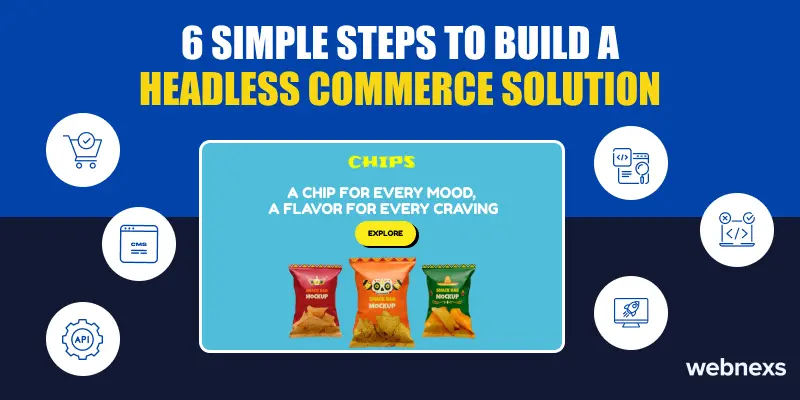
Want to build an effective headless commerce solution? Here are six essential steps you need to follow for a seamless and high-performing ecommerce platform:
- Step 1: Choose the Right Headless Ecommerce Solution
- Step 2: Select a Compatible Headless Content Management System (CMS)
- Step 3: Identify the Ideal Front-End Framework
- Step 4: Set Up and Optimize APIs
- Step 5: Develop and Test Your Headless Commerce Solutions
- Step 6: Launch and Monitor Your Headless Commerce Solution
By 2025, 35% of businesses will shift from monolithic systems to headless commerce solutions, leveraging flexibility and scalability to enhance customer experiences and adapt to market demands effectively.
Here’s a detailed breakdown of how to build a headless commerce solution step-by-step:
Step 1: Choose the Right Headless Ecommerce Solution
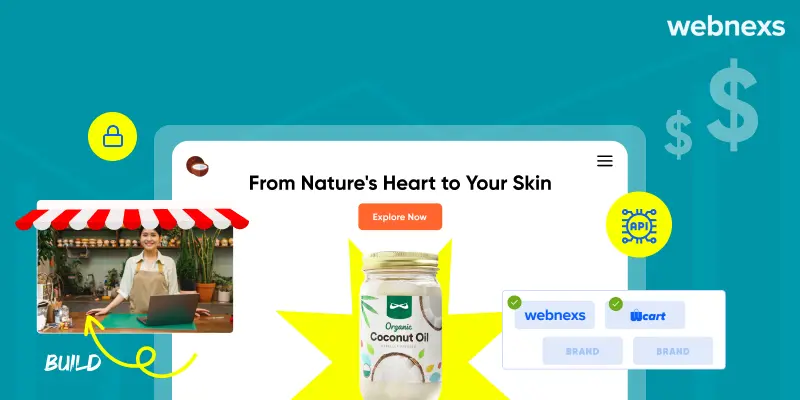
Selecting the right headless ecommerce solution is an important step when building an online store that’s capable of growing and adapting to future needs. Headless ecommerce works by separating the front end from the back end (the underlying system that powers everything), offering you more control over design, improved performance, and better integration with other tools.
Why Choose a Headless Solution?
Headless platforms, such as Webnexs, Wcart, or custom-built options, use APIs to provide businesses with the flexibility to create tailored shopping experiences. These platforms handle key tasks like managing product catalogs, processing payments, and organizing shipping all while streamlining development time.
Key Points to Consider:
- Scalability: Make sure the platform can grow with your business.
- Flexibility: Choose a platform with strong APIs, so you can easily customize it and integrate third-party tools as needed.
- Performance: Opt for a fast, reliable platform that performs well under pressure.
- Integration: Pick a platform that works well with the systems you already have in place.
- Cost and Security: Check both the pricing and security features to make sure they match your needs.
- Customization: Ensure the platform can be easily adapted to your specific requirements.
Whether you’re just starting or running a larger operation, headless ecommerce solution offers flexibility and the ability to scale. Take the time to carefully evaluate your options to ensure you choose the right platform for your business now and in the future.
Fit for Your Business
Not every ecommerce platform is the right choice for every business. The best platform for you will depend on your company’s size, ecommerce model, and growth plans.
Whether you’re a small business or a large enterprise, headless solutions offers the flexibility and scalability needed for success. The API-driven structure allows you to add new features or make changes without a full system overhaul, saving both time and money.
As your business grows, headless solution helps you maintain a smooth customer experience while expanding your operations. Be sure to thoroughly assess each platform’s features to ensure they fit your goals and position your business for long-term growth.
Step 2: Select a Compatible Headless Content Management System (CMS)
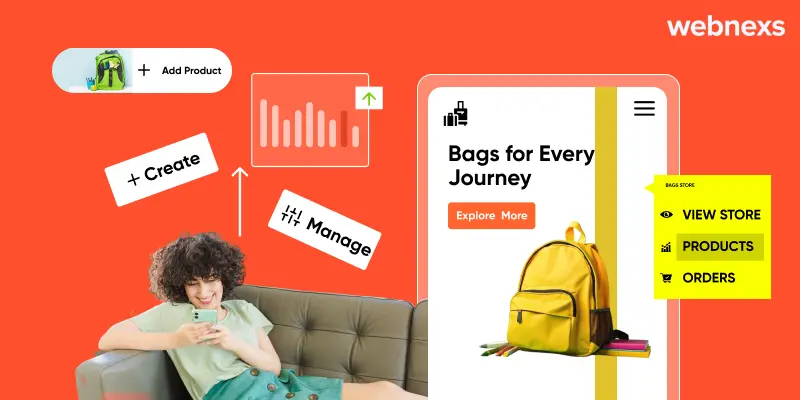
Choosing the right headless CMS is key to smoothly connecting with your ecommerce platform and delivering personalized, engaging content across different channels. A headless CMS separates how content is managed from how it’s delivered, which makes it a great option for businesses aiming to succeed across multiple platforms.
Why Choose a Headless CMS?
Traditional CMS platforms manage both content creation and delivery, but they can be restrictive. To share content across different channels like websites, apps, or social media, you often need separate tools, which can slow things down and create extra work.
On the other hand, a headless CMS uses APIs to make everything simpler. It lets businesses create, manage, and distribute content from a single platform, so it’s easier to send content to different places. This leads to a smoother experience for users and more flexibility for businesses.
Types of Headless CMS Solutions:
1. Open-Source Solutions
- Demands technical expertise for configuration and upkeep.
- Grants developers unrestricted access to the code, allowing for extensive customization.
- Perfect for organizations with in-house technical teams wanting full control over their CMS.
2. Software-as-a-Service (SaaS) platforms
- Offers flexibility and ease of use without needing in-depth technical knowledge.
- Hosted and maintained by the provider, so you don’t have to worry about managing infrastructure.
- Ideal for businesses that want fast deployment and scalability.
Pro Tip:
Choose a CMS that supports omnichannel delivery to reach different customer touchpoints. Personalizing content across these channels boosts engagement and leads to better business results.
Step 3: Identify the Ideal Front-End Framework

The front-end framework you pick is a key part of how your ecommerce store will look, work, and feel to customers. It’s the base that helps you build a smooth, responsive, and user-friendly site. Some of the most commonly used frameworks are React, Vue.js, Angular, and ExpressJS.
Why Choosing the Right Front-End Framework is Important
Picking the right framework offers some benefits:
- Better Speed: Lighter frameworks ensure your site loads quickly, even during traffic surges.
- Enhanced User Experience: These frameworks come with built-in tools and components that make it easier to create a smooth, engaging experience for your visitors.
- Customization: They offer flexibility to create a design and layout that fits your brand’s unique identity.
- Scalability: As your business grows, these frameworks can scale with you, handling increased traffic and more complex needs.
Popular Frameworks to Consider
- ReactJS: React is lightweight and component-based, making it an excellent choice for small to medium-sized projects where flexibility and speed are key.
- Vue.js: Vue is simple to use and perfect for projects that need quick development and easy setup.
- AngularJS: Angular is a powerful, all-in-one solution for large-scale applications that need advanced features and scalability.
- ExpressJS: If you’re running a backend-heavy ecommerce site, ExpressJS is a solid choice that integrates well with APIs and provides reusable components.
Key Considerations When Choosing a Framework
There are a few things to keep in mind when picking the right framework for your ecommerce site:
- Ease of Use: How quickly can your team pick up the framework and get to work?
- API Compatibility: If you’re using a headless ecommerce model, make sure the framework can handle the integration between the front end and back end smoothly.
- Design Flexibility: Does the framework give you the freedom to create a custom design that fits your brand and customer needs?
- Long-Term Growth: Can the framework accommodate your growth as your site and traffic increase?
Selecting the right front-end framework is essential for creating an ecommerce site that not only looks appealing but also functions efficiently and scales with your business as it grows.hows these CMS solutions are technical complexities.
Unlock the Power of Headless Tech Now!
Step 4: Set Up and Optimize APIs
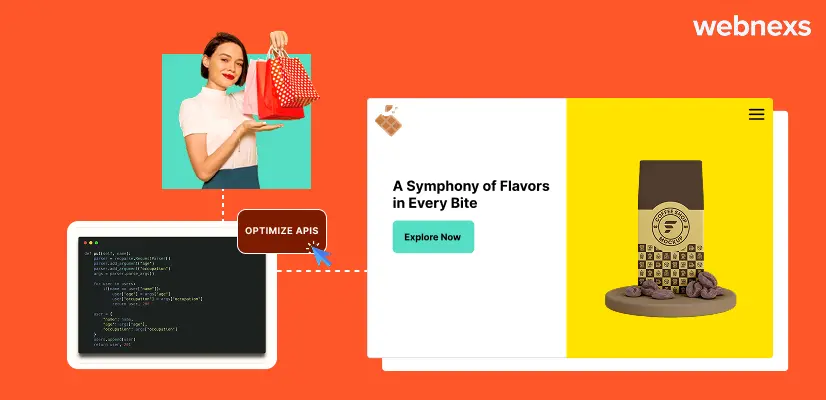
In headless commerce, the role of APIs is simple but crucial they link the back-end platform with the front-end, often through a CMS. Fine-tuning how these systems communicate helps make sure data moves effortlessly, creating a smoother, more enjoyable experience for the user.
Why APIs Matter:
- Enable Smooth Communication: They connect all parts of the system efficiently.
- Provide Real-Time Data: They ensure the information stays accurate and up-to-date.
- Allow Flexibility: APIs make it easy to add new features or customize the system without breaking anything.
How to Set Up APIs:
1. Identify Your System’s Needs:
- Assess the requirements of your ecommerce platform and front end.
- Define the data and functions that need to be synced.
2. Choose the Right API Types:
- REST APIs: Popular and reliable for standard integrations.
- GraphQL APIs: Allow for precise data retrieval, reducing unnecessary data load.
- JSON APIs: Lightweight, fast, and scalable for efficient solutions.
3. Integrate APIs with Your CMS:
- Make sure your CMS and ecommerce solution are in sync for smooth content delivery.
- Ensure the APIs align with your system’s setup for seamless operation.
4. Optimize and Test Performance:
- Regularly check how well the APIs perform under different conditions.
- Use caching to speed things up.
Key APIs for Headless Commerce Success:
- Catalog APIs: Help display product information dynamically.
- Order APIs: Streamline the checkout and order management process.
- Payment APIs: Ensure secure and efficient payment handling (e.g., Stripe, PayPal, Braintree).
- Shipping APIs: Allow for real-time shipment tracking and smooth integration with logistics.
The Benefits of Syncing APIs: By Properly Syncing Your APIs, You Can:
- Avoid data errors and mismatches.
- Improve the speed and reliability of the user experience.
- Ensure smooth integration of new features without disrupting customer interactions.
When APIs are set up and optimized correctly, your headless commerce solution becomes a flexible, powerful system that offers a great shopping experience and is ready for future growth.
Step 5: Develop and Test Your Headless Commerce Solution
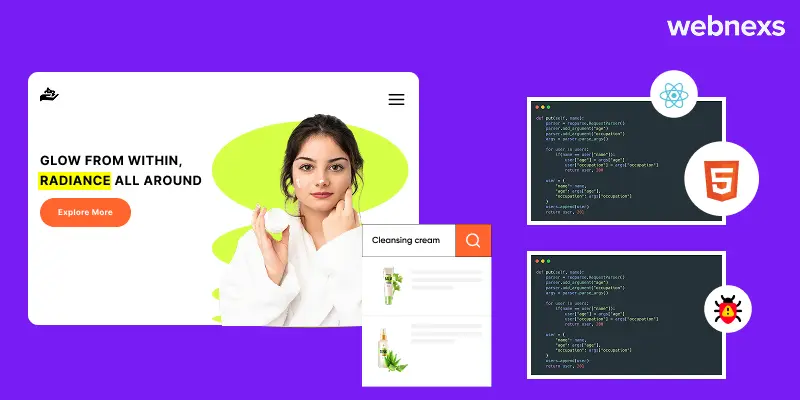
After setting up your API, it’s time to connect the front end with the back end to make your ecommerce platform work. Choose a front-end framework that matches your needs, and create pages that are simple to use and visually appealing to your customers.
Design key pages like product listings, checkout, and the homepage with the user in mind. Make navigation intuitive and ensure the layout is clean and responsive, especially for mobile users. A seamless design helps customers find what they’re looking for without frustration.
As you work on the front end, regularly test your APIs to ensure they’re delivering accurate, real-time data. This step is critical to creating a consistent shopping experience across different devices. Don’t overlook performance optimize for fast loading speeds to improve user satisfaction and boost engagement.
Make sure everything works perfectly before launching your ecommerce site. Use tools like Postman to verify the APIs are properly integrated and the front end interacts smoothly with the back end. Don’t forget to test the site’s speed and reliability to ensure it’s ready for your customers.
With careful planning, thorough testing, and performance tuning, you’ll create an online shopping experience that’s fast, easy to use, and designed to keep your customers happy.
Step 6: Launch and Monitor Your Headless Commerce Solution
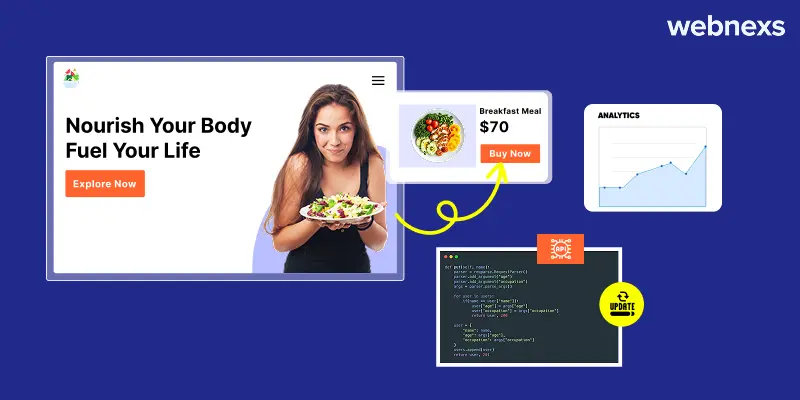
After you’ve set up and integrated your headless commerce solution, it’s time to launch and track how it’s doing. Keeping an eye on its performance will make sure everything runs smoothly and your customers stay happy.
What to Focus On After Launch
1. Keep an Eye on Key Metrics
Use analytics tools to track things like user activity, conversion rates, and how customers are navigating your site. These insights show you what’s working and what needs improvement.
2. Stay Updated with Technology
Regularly update your APIs and front-end tools to keep up with the latest technology, security requirements, and customer expectations. These updates ensure your platform works efficiently and delivers a great experience.
3. Fine-Tune Content and Design
Take what you’ve learned from analytics to improve your content, simplify navigation, and make your site more user-friendly. Small changes can make a big difference in keeping your customers engaged and satisfied.
Why Monitoring Matters
Headless commerce is flexible and powerful, but it requires ongoing attention to stay ahead of trends and meet customer needs. Regular updates and adjustments will help you keep your platform running smoothly while giving your customers a seamless shopping experience.
At Webnexs, we recommend using a CMS that works seamlessly with pre-built headless commerce APIs. It’s an efficient setup that ensures better performance, easy scalability, and smooth operations. If you’re shifting from a traditional ecommerce platform, consulting headless technology experts can help you make the transition smoother and more effective.
Actionable Insight: Choose a scalable, API-driven headless ecommerce solution and CMS that supports customization and omnichannel delivery. This approach ensures smooth integrations, faster performance, and a tailored shopping experience, positioning your business for long-term growth and success.
Discover How Headless Tech Can Boost Sales
Why Headless Commerce Solution is Right for Your Business?

Headless commerce solution is gaining traction because they let businesses separate the design and functionality of their online stores. By doing this, companies can offer more personalized shopping experiences that work seamlessly across various platforms, like mobile, websites, and even voice assistants. This flexibility makes it easier to connect with customers wherever they are.
In the long run, companies that adopt headless commerce solutions are setting themselves up for success and growth. It’s becoming harder to compete in the ecommerce space without using a headless solution. The benefits such as less coding, more flexibility, and better quality have made headless technology an increasingly popular choice for many businesses.
Actionable Insight: Implement headless ecommerce solution to separate front-end design from back-end functionality, enabling faster customization and seamless omnichannel experiences. This flexibility enhances user engagement, improves performance, and ensures your business stays competitive in ecommerce.
There are Several Reasons Why You May Want to Consider Investing in Building Headless Commerce Solutions For your Ecommerce Platform
By 2025, 60% of major North American retailers are expected to adopt headless commerce platforms, enabling faster innovation, enhanced customer experiences, and seamless omnichannel delivery to stay competitive in the evolving ecommerce industry.
1. Increased Flexibility
Headless solution lets you customize the front-end user interface independently of the back-end functionality, providing greater flexibility to meet the needs of your business and users.
2. Faster Time to Market:
Separate front-end and back-end development allows you to make changes and deploy updates more quickly without impacting the underlying functionality of the platform.
3. Improved User Experience
A decoupled architecture allows for greater personalization and optimization of the user experience across different channels and devices, which can lead to improved engagement and higher conversion rates.
4. Scalability
A headless solution can be more scalable and adaptable to new technologies and devices, as the front end can be developed independently and optimized for specific use cases.
5. Future-Proofing
By investing in a headless solution, you can future-proof your ecommerce platform by making it more adaptable to emerging technologies and changing user preferences.
6 Benefits of Headless Commerce Solution for Your Business
Building an ecommerce website is a lot easier now as headless commerce solution allows businesses to have great flexibility in adopting new features and functionalities.
All thanks to the robust ecommerce APIs, SDKs, and other tools to build agile headless ecommerce websites.
Building a website with headless commerce solutions offers several vital benefits for your business, they’re:
- More secure and flexible than the conventional system.
- Load pages faster than in the traditional platform.
- The more fabulous user experience offered by the modern frameworks.
- Developers have the upper hand in setting up new platform features.
- More control over the system for the admin.
- Easier for the site’s editor to use CMS to promote products online via multiple channels.
Actionable Insight: Adopt a scalable, API-driven headless commerce solutions for faster performance, security, and omnichannel flexibility, ensuring seamless integrations, superior user experience, and long-term business growth in the evolving ecommerce market.
Elevate Your Business with Cutting-Edge Headless Solution
Best Practices for Building Headless Ecommerce Solutions
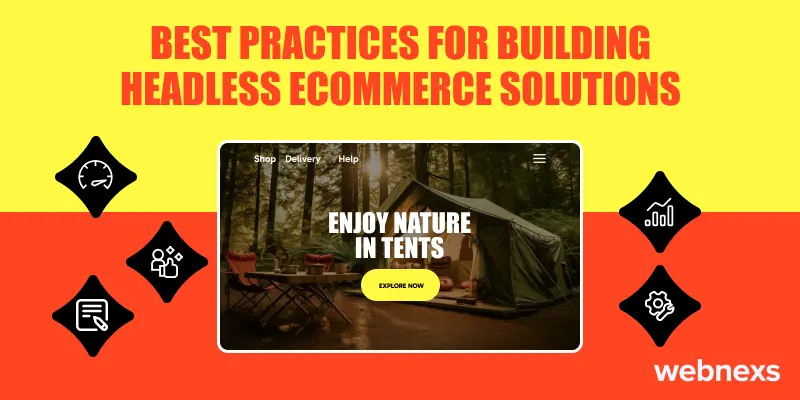
Headless commerce solution are gaining traction as businesses prioritize flexibility and customization in their online selling strategies. With the ability to decouple the front end from the back end, these solutions empower brands to deliver superior user experiences across various platforms. Below are some best practices to consider when build a headless commerce website
1. Prioritize Performance and Speed
Performance is critical to ensuring user satisfaction and high conversion rates. Headless ecommerce solutions should focus on creating lightning-fast websites and applications.
- Utilize caching, Content Delivery Networks (CDNs), and performance optimization tools to minimize load times.
- Ensure that APIs are optimized for efficient data fetching to deliver seamless user experiences.
2. Provide a Seamless User Experience Across Devices and Channels
Consistency is key when delivering experiences across multiple platforms, including desktops, mobile devices, and tablets.
- Design a responsive user interface (UI) that adapts to different screen sizes and devices.
- Leverage the flexibility of headless architecture to provide uniform experiences across websites, mobile apps, and other digital touchpoints.
3. Implement Effective Content Management Strategies
Content is at the heart of any ecommerce platform. A strong content management strategy ensures that content remains organized and accessible.
- Use a headless CMS capable of handling content delivery across websites, mobile apps, and social media platforms.
- Centralize content management to streamline updates and maintain consistency across channels.
4. Leverage Data Analytics to Inform Decision-Making
A significant advantage of headless e commerce is the ability to gather data from various sources.
- Use analytics tools to track user behavior, monitor sales, and identify emerging trends.
- Incorporate insights into your strategy to optimize customer experiences and make data-driven business decisions.
5. Invest in Ongoing Maintenance and Optimization
Headless ecommerce solutions require continuous updates and optimizations to stay effective.
- Develop a maintenance plan that includes regular software updates, bug fixes, and security patches.
- Implement techniques like A/B testing to refine user experiences and ensure peak performance over time.
Actionable Insight: Focus on performance, responsive design, centralized content management, data analytics, and ongoing maintenance to create a scalable, seamless headless ecommerce solution that enhances user experiences and drives growth.
Top 8 Headless Ecommerce Solution Use Cases
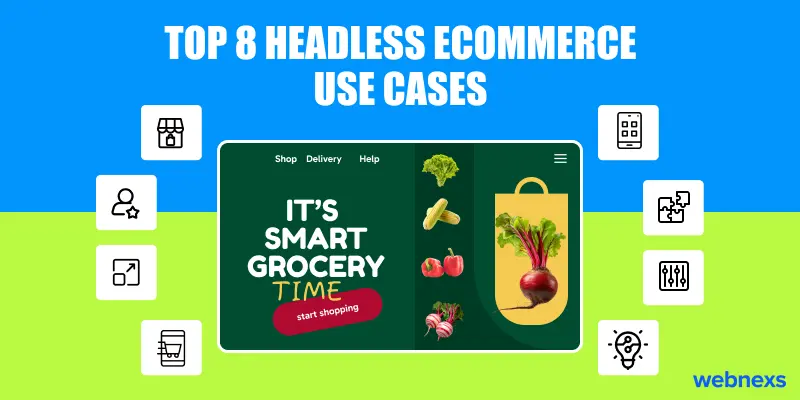
A new approach to building ecommerce websites where the front-end and back-end are decoupled from each other. This allows for greater flexibility and customization in the user interface, while also making it easier to integrate with other systems and services. Here are some use cases where headless commerce can be particularly beneficial:
1. Omnichannel Commerce
Brands using headless commerce for omnichannel experiences report a 30% increase in customer satisfaction and a 20% boost in conversion rates across various shopping channels.
Headless commerce solutions enable brands to create a seamless experience across multiple channels, including online, in-store, and social media. This flexibility is essential for omnichannel retailing, as it allows brands to deliver a consistent shopping experience to customers, no matter where they engage with the brand. By integrating these channels, businesses can ensure that customers receive the same high-quality service and personalized experience, whether shopping online or in-store.
2. Customized User Experiences
80% of consumers are more likely to purchase from brands offering personalized experiences, and 74% of online shoppers feel frustrated when website content is not personalized.
Developers have complete control over the front end, enabling them to create highly customized user experiences. Eventually, this can include anything from personalized product recommendations to immersive augmented reality experiences.
3. Scalability
68% of companies using headless technology report significant improvements in scalability, allowing them to adapt quickly to market trends and customer demands.
Headless commerce architectures, particularly composable commerce, are highly scalable, enabling businesses to quickly add new features and services as they grow. Over time this can help businesses to keep pace with changing customer needs and market trends.
4. Mobile and IoT Commerce
By 2025, mobile commerce is projected to account for 72.9% of total ecommerce sales, while IoT-connected devices will reach 75 billion, enhancing shopping interactions and brand engagement.
Headless commerce makes it easier to create mobile apps and other digital experiences that can interact with your ecommerce backend. This is particularly important as more and more consumers are using mobile devices and IoT devices to shop and interact with brands.
5. Progressive Web Apps (PWAs)
PWAs can boost user engagement by 50%, increase conversion rates by 36%, and reduce load times by up to 85%, making them ideal for enhancing headless commerce experiences.
PWAs are web apps that can be accessed through a browser and offer features similar to native mobile apps. Generally, headless tech can be used to create PWAs that offer a fast and seamless shopping experience by leveraging advanced front end technologies.
6. Personalization
Businesses using headless commerce for personalization see up to a 20% increase in conversion rates, as tailored experiences based on customer data enhance engagement and satisfaction.
Headless commerce allows businesses to easily gather and analyze data on their customers, at the same time it can be used to personalize the shopping experience and improve conversion rates.
7. Third-Party Integrations
Approximately 70% of businesses report that a headless commerce solution simplifies third-party integrations, improving operational efficiency by seamlessly connecting with customer relations management software, payment gateways, and marketing tools, reducing manual tasks and enhancing CRM customer management.
Headless commerce makes it easy to integrate with third-party services such as CRM software, inventory management, payment gateways, marketing automation tools, and shipping providers.
By seamlessly connecting these systems, headless commerce solutions enhance CRM customer management, allowing businesses to manage customer data, interactions, and service more effectively. This integration helps streamline operations, reduce manual work, and improve overall efficiency in managing your e-commerce store.
8. Innovation
68% of companies using headless commerce state it enhances innovation by allowing seamless testing of new technologies and features, resulting in quicker iterations and improved competitiveness.
Correspondingly it allows businesses to easily test new technologies and features without being constrained by the limitations of their ecommerce platform.
Conclusion
Creating a strong, scalable headless commerce solution is the smartest way to deliver great customer experiences, improve efficiency, and grow your business faster. A headless setup gives you the freedom to keep up with new trends and stay ahead of the competition.
At Webnexs, we make this simple with clear, proven solutions that help you meet today’s digital shoppers’ expectations and boost your profits.
Staying with old systems can hold you back. But with the right headless architecture and tools, you can build a flexible online store that’s ready for the future.
Let’s build it together. Contact us today or book your free demo and see how our headless commerce solution can grow your revenue and your business. Don’t wait—let’s get started!






43 Responses
Following a pandemic that forced consumers to shop exclusively online, brands must now embrace innovation more than ever.
Instead of committing to a packaged deal (a head tightly coupled with the related backend services), headless commerce advocates buying a standalone product.
Very good blog on headless commerce solutions in 2023. You explained everything very well and explain each and every point. Thank you for such an amazing post.
The best thing is to go with a headless commerce solution that is built on a trending technology stack like NodeJS. That’s great to know!
Businesses can swiftly roll out new front-end experiences thanks to headless commerce. It is possible to respond to a new market trend quickly and with less expensive back-end work.
The headless solution comes standard with more than just REST APIs, unlike commercial products or managed services contracts.
We’d like to give some clarity and answer frequently asked questions regarding upgrading your ecommerce architecture because headless can seem intimidating (there’s a lot of lingo).
In order to avoid having to create their own IoT device or start from scratch with back-end solutions, the solution is headless content management. Headless content management is the solution, and headless eCommerce is a logical extension.
Now, the question is how you can recognize the best ecommerce platform that satisfies your requirements.
The idea of using a headless architecture for ecommerce experiences is one of the most hotly debated trends in digital commerce technology.
There are uses for monolithic solutions as well as uses where headless commerce is not appropriate. Your opinion, please.
Will that help you build an eCommerce store at zero or very low cost with extensive eCommerce features?
Although the overall landscape can sometimes be a little hazy, the fact that more and more brands are vying for the title of “headless standard” is excellent news for eCommerce companies.
While requiring less development effort to support all of them, a decoupled headless commerce platform may maintain consistency across all touchpoints.
Both direct-to-consumer and business-to-business transactions can be handled by headless commerce solutions.
About twenty-five percent of all B2C and B2C transactions will be via the Headless commerce platform. Now, how could retailers possibly go with them? Do you think they would?
Consolidating those technologies into a headless commerce platform will facilitate resource savings. This is my general idea; can you please check that? Could you help me develop an e-commerce site for my business?
Thanks, I’ve just been looking for information about how to build a headless commerce platform and make better revenue from an ecommerce business, and yours is the greatest I have come upon till now.
Headless items, on the other hand, offer limitless potential in the front. This incorporates IoT-powered instruments that can be promptly coordinated into the headless CX stage.
You can choose the e-commerce platform according to your requirements, but one good thing about headless is that it suits every single requirement.
Simply do headless deployment for your ecommerce site with a Progressive Web App (PWA) frontend, for example, with a PWA Studio that’s been developed to make this easier for merchants to do. This will help anyone looking to get into e-commerce.
Headless commerce saves brands from multiple expenses. from hosting to licence and maintenance prices of heritage platforms to managing multiple shops for ecommerce. Webnexs, thank you for posting.
This a great blog, People are giving you some ideas about the essential part of an e-commerce platform. I think everyone agrees with these things.
Most ecommerce solutions I personally searched for are very cost-effective but lack basic features, while others are expensive yet have fewer customization options. But how about the headless solution, as I’m looking to build one for myself?
Traditional e-commerce models can make even little projects into enormous difficulties since updating the front- and back-end systems to accommodate new experiences can be necessary.
Go for a headless commerce solution, through which you can have multiple storefront channels. Didn’t it do that for those built using it?
This one piece of software, a headless ecommerce platform, would manage product, customer, and order data, the look and feel of the website, and integrations with other systems.
Developing this next-generation e-commerce solution with the headless platform is good right?
Was the headless e-commerce solution all based on the dynamic website that is being developed?
Usually, “headless” means that the website is not just one page and is more like a shopping cart that visitors can choose from; if so, redirect me to the team with whom I can share my e-commerce business requirements.
Headless eCommerce is a term that describes an online store that does not have a home page, which means that it will serve whatever the user wants or is looking at, according to what I’ve heard.
The choice of a headless commerce platform depends on your goals, your system’s capabilities, and your budget (naturally). Think of Webnexs as becoming headless.
The sole goal of a headless solution serving the SMB market Is this platform also available to businesses? or is it limited to SMBs?
It follows that you can design the ideal solution for your company without constraints, constraints, compromises, or consulting agreements.
Great insights! Headless commerce solutions offer unmatched flexibility, allowing businesses to customize the front end and back end independently for a truly personalized shopping experience. This decoupling empowers brands to create seamless omnichannel experiences without the constraints of traditional platforms.
Headless ecommerce solution has emerged as a methodology that leverages the omnichannel capabilities of headless or decoupled CMS, extending these advantages to the eCommerce market.
Webnexs and their headless solution are great and awesome eCommerce solutions on NodeJS; if needed, you people should try it out. Also, thanks for writing this up.
Merchants are free to add, remove, and modify specific services from their headless stack, including headless CMS, to create a best-of-breed solution that meets their unique needs.
By separating the frontend and backend in a headless marketplace solution, we can make the backend much more generic. So what happens if we do that? When the appropriate API requests are sent, it can seamlessly communicate with virtually any system.
If all of that is true, please respond, I’d like to start an ecommerce business, either with a headless commerce platform or whichever option is considered the best.
These features are an important part of any e-commerce platform, and I recommend an incredible headless eCommerce solution: Headless with Webnexs. Hopefully, it will help you.
To create a unified commerce experience, headless eCommerce solutions power all customer touchpoints on a single platform.
The new fancy term “headless commerce” is making a lot of noise in the UK’s online retail sector, and I think it’s not limited to that country. Headless commerce solutions are gaining traction globally as more businesses seek flexibility and faster digital experiences. Do you have any comments?